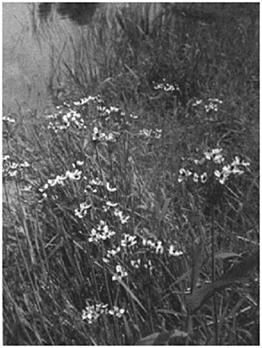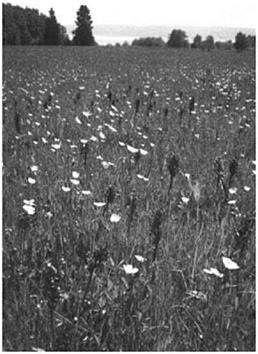Besides water depth and nutrient conditions, Plant Sociability has to be a consideration in the way that plants are arranged, drawing guidance from the way plants arrange themselves in nature. Vegetation planted in a naturalistic style achieves its visual appeal not from groups of single species in neighbourhood arrangements, as is practiced in ornamental borders, but mostly from combinations in different layers. For example, tall growing species should be used in much smaller numbers than lower growing ones. The largest percentage should be made up by shallow ground-covers. It must be admitted that in more productive sites and water bodies, and over larger areas where maintenance will be extensive, there is little purpose in devising detailed planting arrangements or drawing up an intricate planting plan: wetland plants tend to form spreading masses that soon obliterate any patterns imposed by the designer. However, in oligotrophic waters, in smaller-scale sites or where maintenance can be more intensive (in a garden situation, for example) then the following categories may be of use—the six categories can be characterised in accordance with Borchardt (1996), conforming to wetland habitats.
– Monoculture forming plants—invasive competitors, forming extensive populations and
suppressing other species. Loose-growing species can be combined with shade – tolerant ground-cover plants. Vigorous grass-like species belong to this category, for example Phragmites australis, Typha spp. and Zizania latifolia. In wet meadows and marginal vegetation there are also competitors with dense growth, for example Petasites hybridus, Matteuccia struthiopteris and Carex acutiformis.
– Dominant plants—usually tall-growing clumpforming tussock plants. These have to be
used at a distance from other solitary species to achieve the best visual effect. Planted
densely, a meadow-like impression will be produced. In this case not too many different flower colours should compete at the same time. Examples include Iris pseudacorus, Carex pendula and
|
|
8.12
Butomus umbellatus, a companion plant for use in clusters and clumps
|
|
8.13
Aster nemoralis is an important late flowering wetland species
Lysichiton americanus.
– Companion plants—mostly semi-tall plants forming clusters and clumps. These should
be planted in small groups or as neighbours for the structural solitary species. Examples include Iris laevigata, Pontederia cordata and Carex diandra.
– Ground-cover plants—these should be distributed more or less under all plants of the
above categories. In plantings designed to achieve a clear structure with perceptible layers, ground-covers should be more than 50% of the total number of plants. If a more or less dense meadow-like character is intended, lower amounts are justified. Examples include Veronica beccabunga, Lysimachia nummularia and Carex davalliana. In bog plantings, Sphagnum mosses are used as ground-covers simply by pressing them flatly on to the wet substrate surface.
– Scattered plants—in this category we find several important forbs without a great need
of space and with a limited display period. They should be loosely distributed between groundcovers and companions. In bog and fen plantings, many of these species, such as orchids, sundew or gladioli, are expensive, so initially only a few can be planted but they should propagate themselves by seeding. With suitable conditions, three Dactylorhiza plants can generate a hundred-strong group of flowering offspring from seed within about five years.
 |
– Sown species—these particularly involve hemiparasites, which cannot be established by planting. Hemiparasitic species tap into the roots of host plants and obtain some of their nutrition from the host plant but are also able to photosynthesise for themselves. They are typical of less fertile sites and are relatively common in nutrient-poor wetland systems. The best date for sowing is in the autumn, as cool temperatures break the seed dormancy, and germination starts in early spring. Many such
 dominant plants companion plants groundcover plants
dominant plants companion plants groundcover plants
scattered plants
8.14
Distribution pattern of plants according to grouping categories
species have a long-term flowering display. The growth rate of the parasatised species will be reduced, but not disturbed too heavily by the semi-parasites. Hemiparasites are primarily members of the Scrophulariaceae-sub-family Rhinanthoideae: Rhinanthus serotinus (annual), Pedicularis palustris (biennial) and Pedicularis sceptrum-carolinum (perennial).
Besides hemiparasites there are also several short-lived perennials, biennials or annuals that may be introduced into planted vegetation by sowing. However,
competitiveness has to be considered very carefully when choosing these species, for some spread extensively by seeding themselves. Short-lived species from fertile wetmeadows, such as Bidens spp., Juncus articulatus or Aster tripolium, can look very pleasing but are only suitable to sow in small amounts between competitive tall forbs (Filipendula, Lythrum, Mimulus ringens). The establishment of herbaceous plants by sowing in situ is discussed in detail in Chapter 6. Several short-lived Primula, Linum catharticum, Carex viridula or even scattered plants, as mentioned above, can also be sown successfully into low growing plantings with the character of poor bogs or fens.
These grouping categories should be followed in both planted and sown vegetation. On flooded sites, vegetation is established mostly by planting, but wet meadows on terrestrial sites can be initiated by pure sowing too. The grouping categories can be applied to the proportions of seed numbers per species. Further information on the grouping of plants according to Plant Sociability is given in Chapter 9.





